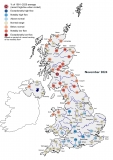Submitted by Steve Turner on
The UK Surface and Groundwater Archives Committee (SAGA) convened for its 38th annual meeting held online earlier in March.
The SAGA Committee comprises representatives of organisations from across the UK involved in the measurement, management or use of hydrometric data. This year’s meeting was attended by members of the UK Centre for Ecology & Hydrology, British Geological Survey, Scottish Environment Protection Agency, Environment Agency, Natural Resources Wales, Met Office, Canal & Rivers Trust, Welsh Government, British Hydrological Society, Chartered Institution of Water and Environmental Management and representatives from the UK water industry. Amongst the items discussed at this year’s meeting was a review of the activities of the NRFA over the last 12 months.
2020/2021 as we all know too well, was very different from previous years and necessarily the NRFA operations moved into respective team member’s homes. The usual liaison visits with our colleagues in the Measuring Authorities also could not go ahead as planned. Thankfully we were able to continue almost business as usual in regards to the NRFA’s ongoing updating and maintenance of the nation’s central database for hydrometric data. Ensuring that the archive is up-to-date involves an intensive programme of year-round work to quality control new data before it is added to the archive alongside reviewing existing data. The NRFA’s core daily mean flow dataset alone was subject to around 700,000 updates and changes in the last 12 months.
The annual update to the archive this year contained data for the water year 2018/2019, which included several new record flows across the UK. Alongside the routine update to daily flow data, an annual update to peak flow data as well as a period of record review of a subset of peak flow stations led to the release of Version 9 of the NRFA Peak Flow Dataset, and some 6,000 station years of data reviewed.
NRFA staff continued to liaise and engage with key stakeholders and the user community, with presentations at the Royal Meteorological Society, the British Hydrological Society’s Seminar Series and the Nordic Hydrometry Workshop.
The NRFA website remains very popular and has seen sustained activity in 2020/2021. There were around 30,000 downloads of river flow, spatial and metadata and around 700,000 page views by 60,000 users across all pages on the NRFA website. Updates to the website included the addition of interactive rating plots and new features added to the UK Water Resources Portal. The NRFA API has also increased in usage this year with data downloaded over 500,000 times.
The National Hydrological Monitoring Programme (NHMP), operated jointly by the UK Centre for Ecology & Hydrology and British Geological Survey has continued to publish the monthly Hydrological Summaries for the UK. The NHMP analyses of NRFA data also contributed to three peer-reviewed papers on the drought in 2018/2019 (Turner et al, submitted), flooding of 2019/2020 (Sefton et al, in press) and an updated analysis of UK-wide flood trends (Hannaford et al, in press). The NHMP published hydrological status updates commenting on the water resource situation.
Isabella Tindall, Head of the NRFA commented “2020/2021 has been an unprecedented yet successful year for the NRFA, with a number of important outputs and updates to our services and the publication of several papers and blog posts. At the SAGA Committee meeting our plans for the next 12 months were discussed. They include further improvement to our tools and systems including the development of new catchment land cover change metrics and the automation of the production of catchment average daily rainfall.



